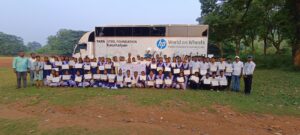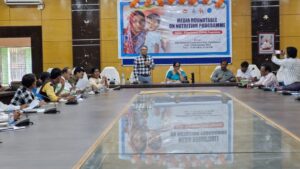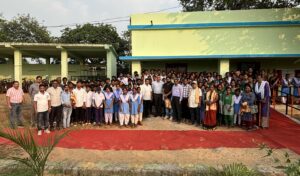KIMS docs with a team from IIT Indore propose model of quick detection of lung pathology from CT-imaging using AI

Bhubaneswar: While the mystery of the COVID attack and the disease progression and organ damage, all remain shrouded in mystery world over, till date, the doctors at city-based Kalinga Institute of Medical Sciences (KIMS), a constituent of KIIT-DU, has come up with a research finding, which could help in better analysis of the CT-Scan reports of the lungs and other vital biochemical parameters so that the lobe-wise study of the lungs and even other organs could be taken up in near future.
The work was carried out by Dr Nirmal Kumar Mohakud, Pediatrics professor, KIMS with Hem Chandra Jha, Associate Professor Dept. of Biosciences and Biomedical Engineering, M. Tanvir, Associate Professor Dept. of Mathematics from IIT Indore, and Dr. Suchita from Choithram Hospital and Research Centre Indore. The study is published in the prestigious IEEE Journal of Biomedical and Health Informatics and comprises more than 1,100 COVID-19 patients. The research findings were published in a high impact publication, IEEE Journal of Biomedical and Health Informatics.
The path-breaking study with a multi-disciplinary study highlights the importance of Artificial Intelligence (AI) and other computational methods that can be used to correctly analyse the extent of damage in lungs in CT scan and detection of the severity of lung pathology with biochemical parameters.
Researcher Prof Mohakud of Department of Paediatrics, KIMS, explained “we had taken the CT-Scan reports of the patients who had come to the KIMS COVID Hospital from 2020 to 2021. As the disease primarily affects the lungs and there is a shortage of radiologists during the pandemic, we thought that if we could take the help of AI, then the study of the CT-Scans of lungs would be easy, accurate, systematic and faster. For these computational parts and AI, we had collaborated with institutions like IIT Indore and other schools of KIIT-DU to make the study need based and effective.’’
He explained that apart from the chest CT-Scan reports, during COVID pandemic tests like D-Dimer, CRP, Serum Ferritin, Troponin – I / T tests were also done and through meticulous studies it was inferred that with the rise of certain levels of D-Dimer or CRP, it has a correlation with lung lobes. It found that C-reactive protein (CRP) is the most critical parameter for classifying symptomatic and asymptomatic groups.
Terming the findings as “models based on numerical and computational findings” Dr Mohakud added that the disease progression in lungs or in other vital organs would be taken up so as to establish a correlation between the COVID situation and organ damage.”
The research article by the team of doctors of KIMS Bhubaneswar has been contributed by Dr AP Mohanty, Dr Amrut Mohapatra, Dr Pritinanda Parida and Dr Shubhransu Patro among others, apart from Dr Jha and Dr Tanveer from IIT,Indore, Namrata Misra,, Kartik Muduli, Bikash R Sahu, Selvakumar Elangovan from KIIT School of Biotechnology.
Explaining further, Dr Mohakud said “the study relies on 2D lung CT-Scans for lobe segmentation and opacity detection (for severity of lung damage). This method through use of AI could accurately predict the level of damage and reduce the chances of manual bias in CT-Scan scoring or Ground Glass Opacity (GGO).
These data also indicate that the effect of inflammation-mediated disease progression might start from the right lobe region and subsequently spread to other parts.’’ Not only analyzing the lobes of lungs, but the study may also be used as a basis for understanding the possible interplay between biomedical parameters and GGO of the specific lobes of the lungs in case of the COVID and in future for other diseases or other organs.
KIIT-KISS Founder Dr Achyuta Samanta has congratulated the KIMS doctors and other teams for their research work and encouraged them to carry out more and more such innovative work from KIMS and addition of knowledge for better COVID diagnosis and management in future.





